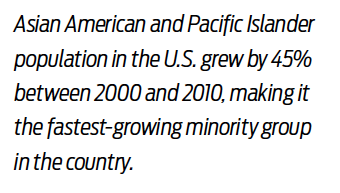Americans are increasingly divided on the subject of immigration, but immigrants play a critical role in driving our housing economy, and, by extension, our long-term economic prosperity.
Phillia Kim Downs has been a luxury real estate agent in New York City for seven years. She is the daughter of South Korean immigrants who came to the U.S. in the 1970s seeking higher education and has been a homeowner since 2008.
“I rented for a year in the East Village of Manhattan but then bought a condo in Williamsburg,” she explained. “Rent is so expensive in Manhattan, so my parents thought it would be a better investment to buy property.” Downs used her savings as well as some financial assistance from her parents to purchase the condo.
“Homeownership has been awesome,” Downs said. “It is definitely part of the American Dream, and it is definitely an investment for our family.” She said that her parents feel a sense of pride in having been able to help her purchase the condo since they “came to this country with nothing, really.”
Downs’ father’s first job in the U.S. was working his own hot dog stand at Yankee Stadium. At the time, he spoke limited English. “To have come from that start, saving money, raising a family here and sending two children to college, and now helping purchase a home for his daughter and to have a home of his own in Philadelphia — I’d say they feel pretty good about themselves.”
Downs’ story is not unique. It is the story of millions. Even as native-born Americans whose families have lived here for generations may have grown disillusioned about homeownership in light of the Great Recession, the American Dream still holds allure for the nation’s vast immigrant populations.
And that allure has serious economic impacts on the United States that are too often overlooked. In an election year where plenty of candidates are talking immigration reform (and some of them pushing for measures that would severely limit immigration), what does closing the borders (or at least substantially limiting influx) really mean compared to keeping them open and even easing access to citizenship?
IMMIGRANTS DRIVE HOUSING AND ECONOMIC GROWTH
Harvard University’s Joint Center for Housing Studies indicates that immigrants have made up 40% of housing demand in the U.S. since 2010. And within a few decades, housing analysts expect immigrants and their progeny to be responsible for the majority of the net growth in households in this country.
Between 2000 and 2013, immigrants or the children of immigrants have accounted for 57% of the country’s population growth, according to a 2014 white paper from the Immigration Task Force of the Bipartisan Policy Center called “Immigration and Housing: Supply, Demand, and Characteristics.” At the same time, immigrant labor has become a critical component in the nation’s construction workforce with 25% of all construction workers identifying as immigrants.
“Immigrants’ growing role in supplying construction labor and driving demand for new housing units makes immigration an important contributor to U.S. economic prosperity,” the white paper authors state. And given that a sluggish housing market overall remains the major drag on post-recession economic recovery, the authors contend that immigrants can and will play a substantial role in re-establishing a healthy housing market.
“[Immigrants] are a big part of housing markets both on the supply and demand sides,” said George Masnick, senior research fellow at the Joint Center for Housing Studies at Harvard University. “They build and buy houses.”
That impact becomes even bigger when one factors in the children of immigrants. “Immigrants and their children are the only thing keeping U.S. labor force growth from going under zero,” said Dowell Myers, professor of policy, planning, and demography at the University of Southern California. “They also patch up the weak spots in our housing market.”
Myers points out that immigrants’ impacts on the housing economy have been growing steadily for decades. In the 1970s, they made up 6% of growth in housing demand. By the 1990s, that impact had grown to 21%. By the 2000s, that number had reached 39%, a number that Myers said is holding steady.
Masnick adds that by 2010, in both California and New York, immigrant household growth represented almost all of the housing growth in both states.
TAKING THE LONG VIEW ON IMMIGRATION
Despite all the media attention focused on Hispanic immigrants, the fastest-growing group of immigrants is actually Asians and, more specifically, Indians. Indians as well as Chinese-Americans are also more likely to own than rent.
Myers said it’s important to keep in mind that “immigrants have delayed impacts three and four decades later,” as their children and grandchildren enter the workforce and begin to rent and buy homes. With Latino immigrants, Myers said it’s generally a three-decade delay from arrival on U.S. soil to home ownership.
According to the National Association of Hispanic Real Estate Professionals, as of the year 2000, Hispanics became the largest minority group in the U.S., outpacing African-Americans.
Meanwhile, the 2015 “State of Asia America” report from the Asian Real Estate Association of America indicates the Asian-American and Pacific Islander population in the U.S. grew by 45% between 2000 and 2010, making it the fastest-growing minority group in the country. Seventy-nine percent of the 19.4 million Asian Americans in the U.S. over the age of 18 are foreign born.
 As with Latinos, Asian-Americans’ numbers are largest in California, New York and Texas, though populations are quickly expanding in Nevada, Arizona and North Carolina as well. On average, Asian-American households have higher median incomes than their native-born Caucasian counterparts, so they represent a group ripe for home buying, which is why native-born Americans should take notice.
As with Latinos, Asian-Americans’ numbers are largest in California, New York and Texas, though populations are quickly expanding in Nevada, Arizona and North Carolina as well. On average, Asian-American households have higher median incomes than their native-born Caucasian counterparts, so they represent a group ripe for home buying, which is why native-born Americans should take notice.
Myers points out that while baby boomers are, for the most part, sitting comfortably in their homes right now with no plans to vacate, that’s going to change in the coming decades. “They are getting older and sitting on $50 million in owner-occupied houses,” he said. “If that demographic wants to cash in on its nest egg, who’s going to buy?”
Immigrants.
There simply are not enough native-born Millennials to fill the gaps without considering immigrants and the Millennial children of immigrants.
Even as U.S. policymakers waffle over whether or not to reform immigration laws and how, more progressive governments are recognizing the economic value of keeping borders open and even driving newcomers to certain areas in need of economic development. Canada, for example, is offering incentives to get immigrants to move to the center of the country, namely Manitoba and Saskatchewan.
“Congress needs to wake up and see how immigrants are very hard working and pursuing the American dream and are basic positive assets to our economy and society,” Masnick said.
“Perhaps the simplest way to accelerate the housing recovery would be to increase the number of people who want to buy homes,” the BPC’s Immigration Task Force concluded. “Basic principles of economics hold that, all else being equal, when the demand for a good exceeds supply, production of that good will increase. Immigration can help to provide this additional demand.”
BARRIERS TO HOMEOWNERSHIP
But even if lawmakers eased immigration into this country for groups hungry for better education and economic prosperity, immigrants still face significant barriers to homeownership, the biggest of which is access to credit. NAHREP’s CEO, Gary Acosta, said the way today’s loans are underwritten hasn’t changed much from 50 years ago. “People earn money in nontraditional ways, and not everybody is a W-2 wage earner,” he said. And that reality applies to the native-born as well. “We need new metrics for analyzing credit worthiness,” he said. “It’s not about lowering the bar; it’s about widening the window.”

Hope Atul, executive director of the AREAA, agrees, noting that lack of access to mortgage financing is also the result of recent immigrants not having a credit history. They may have sufficient funds available for a down payment, but because they came from a culture where borrowing was frowned upon, they can’t present a strong credit score to banks.
Atul says lenders need to employ new credit score modeling methodologies like the Advantage Score as opposed to relying exclusively on FICO. The AREAA is strongly behind passage of H.R. 123, which supports establishment of an alternative credit rating system designed to make home ownership more accessible to immigrants, though Atul admits she doesn’t see that legislation getting anywhere in a presidential election year.
H.R. 123, if passed, would be a boon to all immigrants, not just Asian-Americans, whom Atul sees as unfairly lumped into the same category as wealthy Chinese real estate investors from abroad who purchase everything in cash.
Atul says the housing industry as a whole also needs to look at addressing cultural and language barriers. “What are Asian-Americans looking for in a home? And how do they develop trust?” she asked.
A PLACE TO GO…
When Brooklyn, New York, Realtor Janine Acquafredda’s parents migrated to the U.S. from Puerto Rico in the 1950s, they were looking for the same thing the vast majority of immigrants are — a better life for themselves and their children. Neither was college-educated, but they felt they could build a better life here for the next generation. Acquafredda rented for 10 years, then purchased her first home in 2005.
“I wanted the American Dream,” she said. “I wanted to do what my parents and grandparents couldn’t.” To her, homeownership is a defining feature of success. “I felt it was security. No one else in my family owns. It’s peace of mind knowing no matter what happens, my family always has a place to go.”
MORTGAGES FOR UNDOCUMENTED IMMIGRANTS
Travel to a place like California’s Salinas Valley, the nation’s “salad bowl,” where a significant percentage of the produce you see in grocery stores is raised (think 70% of lettuce and nearly 50% of the broccoli), and you’ll see acres and acres of strawberries, artichokes, lettuce, broccoli, all of it under cultivation and harvested by Latinos. About 80% to 90% of them (according to the farmers who hire them) are undocumented immigrants. Obviously, these immigrants are playing a critical role in the nation’s agricultural economy and the provision of food to our dinner tables, but what about housing?
There are many areas around the country with large populations of undocumented immigrants, many with children and even grandchildren who were born on U.S. soil, and plenty of them want the American Dream. “Immigrants come to this country for economic reasons,” said NAHREP’s Acosta, “and homeownership is a big part of the American Dream.” Given the family-centric culture of Hispanics, it’s not uncommon for multiple adult generations to live under one roof.
And it’s not impossible for an undocumented immigrant with a tax identification number and W-2 to obtain a home mortgage. While Acosta doesn’t see this as a big growth area among traditional financial institutions, he says companies seeking niche markets in an effort to differentiate themselves from the competition are increasingly getting back into the offering of Individual Tax Identification loans.
Prior to the recession, Bank of America had offered ITIN mortgages for undocumented immigrants, and surprisingly, according to Myers, foreclosure rates for those loans have been lower than for other mortgage loans when one controls for the time period when houses were purchased. “Immigrant homeowners depend on multiple income earners,” Myers explained. “They often have down-payment contributions from multiple family members, more earners, and they see the home as an anchor.”
But banks really aren’t keeping up with changing demographics or forms of income earning. “Underwriting,” Myers said, “remains pretty traditional.”
According to the Partnership for a New American Economy, were the nation’s estimated 11 million undocumented immigrants deported, U.S. housing wealth would drop by $1 trillion while the U.S. manufacturing sector would lose about half a million jobs.
Masnick said he thinks banks have been scared off by the fact that in 2009, a lot of undocumented immigrants who found they could purchase homes without much documentation fell victim to the housing bubble like everyone else, lost their construction industry jobs, couldn’t pay their mortgages, and then ended up in foreclosure. But given the new regulatory environment, Masnick said that’s not going to happen again. “Banks are going to have to figure this out, and banks serving high immigrant populations will make allowances.”
Community banks in areas of high immigration population are stepping up to the plate. Las Vegas-based Venta Financial Group, which caters to the Hispanic communities in Nevada, California, Arizona, Texas and Florida, offers ITIN mortgage loans. They are 30-year fixed-rate loans with a 30% down payment requirement.
Venta’s CEO Jason Mediedo said the loans are actually good for lenders. Because of the high LTV ratio and interest rates, they really favor lenders.
Perhaps Acosta may be on to something when he says, tongue in cheek, “The immigrant market is not for everybody, just somebody who wants to be in business in five years.”





